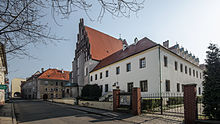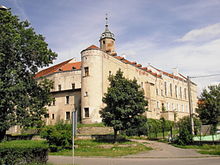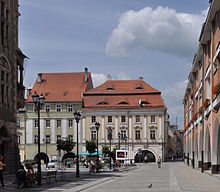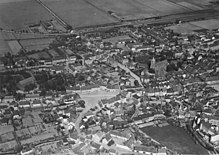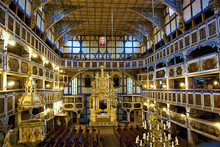Yes
| Yes | ||
|---|---|---|

|
|
|
| Basic data | ||
| State : | Poland | |
| Voivodeship : | Lower Silesia | |
| Powiat : | Yes | |
| Area : | 18.80 km² | |
| Geographic location : | 51 ° 3 ' N , 16 ° 12' E | |
| Residents : | 22,890 (Jun. 30, 2019) |
|
| Postal code : | 59-400 to 59-402 | |
| Telephone code : | (+48) 76 | |
| License plate : | DJA | |
| Economy and Transport | ||
| Street : | E 65 Bolków - Legnica | |
| Rail route : | Jaworzyna Śląska – Legnica | |
| Next international airport : | Wroclaw | |
| Gmina | ||
| Gminatype: | Borough | |
| Residents: | 22,890 (Jun. 30, 2019) |
|
| Community number ( GUS ): | 0205011 | |
| Administration (as of 2016) | ||
| Mayor : | Emilian Bera | |
| Address: | Rynek 1 59-400 Yes |
|
| Website : | www.jawor.pl | |
Jawor [ ˈjavɔr ] (German Jauer ) is a district town in the Polish Lower Silesian Voivodeship . The city is known for its Church of Peace , which since 2001 the World Heritage Site of UNESCO belongs.
Geographical location
The city is located in Lower Silesia on the Angry Neisse ( Nysa Szalona ), a right tributary of the Katzbach , around 70 kilometers west of the city of Wroclaw , and belongs to the Neisse Euroregion .
City arms
The patron saint of the city is Martin of Tours , a saint of the Catholic Church. As early as 1300, the city's oldest seal showed a representation of the legend of St. Martin sharing his cloak with the beggar. From the middle of the 17th century until around 1945 the city coat of arms consisted of two separate shields , on the right the red and black chessboard of the Schweidnitzer Piast , on the left Saint Martin. The official city coat of arms contains St. Martin in a blue field on a white horse, with a red cloak, who hands his cloak down to the half-naked beggar in white sitting on the floor.
history
Among the Silesian Piasts
The name of the city in today's Polish and at the same time the old German spelling appears for the first time in a document dated April 12, 1177 and is of Slavic origin ( Jawor = maple ). In 1750 the name Jawor was also used in the ordinance published by Frederick II the Great for the Silesian residents.
The area was already inhabited before the year 1000, as evidenced by the many urns found in the city and in the neighboring village of Altjauer ( Stary Jawor ). The exact date for the founding of the city of Jawors according to Magdeburg law is unknown, but a pastor Valentinus is documented for Jauer in 1242 , who appeared as a witness for a deed of donation for the Trebnitz monastery .
Jauer developed primarily as a town of craftsmen and farmers and as a place of relaxation for merchants and carters, as it was located next to important trade and military routes from Breslau , Striegau , Goldberg and Löwenberg , which met here. The trade routes Dresden – Breslau and Liegnitz-Prague crossed in Jauer.
In 1278 Jauer became the seat of a ducal bailiff , which raised it to the rank of capital and residence of the independent Piast duchy of Jauer. This was associated with greater political importance, but Jauer was never a princely residence despite the dukes' title "Lord of Jauer". Duke Heinrich I (1301-1346) was very close to the city, but often stayed in the towns on the Bober - Hirschberg , Bunzlau and Löwenberg - from where he made numerous trips to neighboring Lausitz . Nevertheless, he promoted his capital, which he granted several privileges, e.g. B. 1326 the miles right , which included the exercise of the baker's trade and the beer brewing monopoly , and 1329 the privilege of free salt trade and the high and low jurisdiction .
Heinrich I exercised the right to mint coins together with Bolko II and Heinrich II von Schweidnitz. The mint was in Löwenberg . Not only silver coins, but also gold florentines of the Florentine type were minted.
In 1368, Duke Bolko II, "the little one", died with whom the Schweidnitz line of the Silesian Piasts died out. In his will, he had bequeathed his duchy to his niece Anna von Schweidnitz , wife of Emperor Charles IV , or her descendants. As a result, Anna's son, the Bohemian King Wenceslaus, or the Crown of Bohemia , came in 1368 . However, Bolko's widow Agnes von Habsburg was entitled to a lifelong usufruct . In 1371 Agnes granted the city the right to mint silver coins. She lived for a time in a palace next to the Liegnitzer Tor, whose cellar walls from the 14th century have been preserved. It protected the Jews, whose quarter was mentioned as early as 1356. After her death, Jauer Castle became the seat of the royal governor , who resided there until 1741.
Under the crown of Bohemia
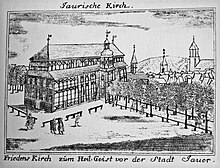
At the beginning of the 14th century, King Wenceslas arranged for the castle to be rebuilt, and the west wing was added. In 1404 the city was given the privilege of holding a Saturday market in addition to the Thursday market that had existed since 1339, which was reserved for the grain trade. During the Hussite Wars in 1428 the area was devastated, but the city itself was spared. Together with Breslau and Schweidnitz, Jauer fought against the Hussites in 1434, so that it was possible to drive them out of the duchies. In the same year the principalities of Jauer and Schweidnitz raised an army of 400 mounted men to pursue the mischief of the ruling robber barons. In 1454 the traveling preacher Johannes Capistranus stopped in Jauer on his way from Breslau to Prague and preached against Hussites and Jews here. Subsequently, 17 Jauer Jews were burned at the stake. A few years later the Jews were expelled from Jauer. In 1459 the Bohemian King George of Podebrady in Jauer received the tribute from the estates.
After the Bohemian King Ludwig II was killed in the Battle of Mohács , the royal dignity of Bohemia fell to Ferdinand I from the Habsburg dynasty in 1526 . Subsequently, in their capacity as kings of Bohemia, they were also dukes of Silesia until 1742. At this time Jauer committed himself to the Reformation ; the first evangelical preacher Samuel Frenzel was called to Jauer in 1526. Around 1559 Jauer was a center of the Silesian linen trade. The town had a bathing establishment since 1543. In 1564 she hired a city physician and in 1586 a surgeon. In 1618 it had 1,400 inhabitants.
During the Thirty Years' War the Jauer estates sided with the Protestants . In 1620 they paid homage to the “Winter King” Friedrich V of the Palatinate at Jauer Castle, and two years later to the Saxon Elector Johann Georg I of Saxony , who came to Jauer as a representative of Emperor Ferdinand II . 1626–1627 Jauer had to supply 1200 soldiers from Wallenstein's army . 1629–1644 Jauer fell several times into the hands of various opposing armies; the Catholics drove out the Protestant clergy and the Swedes the Catholics. Regardless of the confession, Austrians, Swedes and Saxons were involved in the looting and destruction. The Swedes occupied the city from 1644 to 1648; on July 25, 1648, the Liegnitz imperial commandant besieged Jauer. After fierce fighting, the Swedes capitulated. For their collaboration with the Swedes, the Jauerans - mostly Protestants - had to accept punishments. The city was set on fire and devastated, only the town hall, the churches of St. Martin and the monastery as well as some town houses on the ring were spared. At the end of the war in 1648 the city had only 150 inhabitants.
In 1653 an imperial commission toured Jauer's area and returned all of the originally Catholic churches to the Catholic clergy. As the majority of the population in the area was Lutheran, they had to attend church services in the neighboring duchy of Liegnitz , whose Piastic princes were Protestants and granted religious freedom. In 1654/55 the Evangelical Peace Church of the Holy Spirit was built. Along with Glogau and Schweidnitz, it was one of the three peace churches that were granted to the Silesian Protestants in the Peace of Westphalia of 1648. After the Altranstadt Convention was concluded , the Friedenskirche was expanded to include a bell tower in 1709. In 1680 Jauer was hit by a plague epidemic. Otto Christian Ockel opened the first printing press in Jauer in 1683. The introduction of postal services at the beginning of the 18th century was of economic importance.
Prussian time
During the First Silesian War , Frederick the Great occupied Jauer on January 26, 1741. On February 23, the imperial governor was chased out of Jauer's castle. After the end of the war in 1742, Jauer came to Prussia along with most of Silesia . The Battle of Hohenfriedberg was fought near Jauer on June 4, 1745 . In the Seven Years' War Jauer was captured by Austrian and Hungarian troops in 1756 and the Prussian magistrate was dissolved. Jauer and the Principality paid homage to Maria Theresa in her capacity as Queen of Bohemia. After the Battle of Leuthen in 1757, the Prussian authorities returned. In August 1761, Maria Theresa's Russian allies plundered the Jauer area. After the end of the Silesian Wars in 1763 the situation stabilized, but Jauer was burdened with a large debt.
On August 2, 1776, a great fire in Jauer destroyed 137 houses. After inspecting the damage, Frederick II granted the city a sum of 106,000 thalers for reconstruction and sent a master builder to oversee the construction. The appearance of the city is essentially based on its planning. In 1788, a fusilier battalion was established as a permanent garrison in Jauer . With the third partition of Poland in 1795, most of western Poland, including Warsaw, fell to Prussia (until 1806). Encouraged by the Prussian authorities, many craftsmen from Jauer and the Principality emigrated to Poland, especially to areas adjacent to Silesia. In the Napoleonic Wars , after Prussia's defeat at the Battle of Jena and Auerstedt during the French era , Jauer received a French occupation and had to pay a large contribution. During the liberation war in 1813, the Lützow Corps was stationed in Jauer. On August 26th, the Battle of the Katzbach took place in the region .
The Prussian administrative reform dissolved the Principality of Jauer in 1807. After the reorganization of Prussia, Jauer belonged to the province of Silesia since 1815 and was the center of the Jauer district from 1816 to 1945 . In 1818 the city administration published the first newspaper, the Jauersche Zeitung , which appeared until 1945. In 1822 the city received street lighting. In the same year a regular stagecoach connection (to Glogau and Neisse, among others ) was established. Because of the crisis in the Silesian linen industry and the sales markets for handicraft products, many craftsmen emigrated to Russian Poland (especially Kalisch , Łódź and Łęczyca ), as the Russian authorities promised easy business start-ups. The emigrants founded German Protestant communities there, which existed until 1945 and in some cases still exist - as Polish Protestant communities. The city park was laid out in 1844, and in 1856 the city received a railway connection (later the Katowice – Legnica line ). In order to gain more building space for the steadily growing population, the city walls were razed in 1866. In the same year the district hospital was built and in 1869 the municipal high school was opened. In 1901 Jauer received a telephone network. In 1911, the Dresden wholesale merchant Bruno Fuchs, a native of Jauer, donated 5000 gold marks to the city for the construction of a new city park on the other side of the Angry Neisse, which was named after the founder. In 1914–1916 the city was canalised.
Weimar Republic and Third Reich
After the First World War , Jauer was electrified in 1919. The new Prussian administrative reform dissolved the Jauer district in 1932 and incorporated the city into the Liegnitz district . After the NSDAP came to power in 1933, the Jauer district was re-established with Bolkenhain . In the same year, the city took over the management of the theater, which was renamed the Lower Silesian State Theater and subsequently played in numerous neighboring places in Lower Silesia. The Olympic swimming pool ( meadow lido ) was opened in 1935, followed by the sports stadium in the city park in 1936/37. The long-time mayor Heinrich Evert resigned. The temporary district leader of the NSDAP , Erich Tschäpe, took over the office of mayor and remained in this position until 1945. By 1939 the population of Jauer was about 75 percent Protestant and about 25 percent Catholic. The city was connected to the long-distance gas network of Ferngas-AG Silesia, and the old gas plant was shut down. The city had a lyceum, a municipal vocational school and an agricultural school.
During the Nazi era, resistance fighters Maria Fischer , Luise Kanitz (née Lebensaft) and Marie Eckert were imprisoned in the Jauer women's penitentiary , Schlossstrasse 17, along with other prisoners .
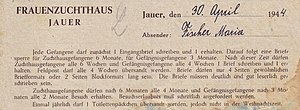
Towards the end of the Second World War , the evacuation of parts of the civilian population to Bohemia began on February 6, 1945. On February 12, 1945, the city was captured by the Red Army . On February 13th and 14th, Soviet soldiers set the city on fire, which destroyed two sides of the ring with historical buildings. On April 28, Jauer was placed under Polish administration by the Soviet military authorities .
The place name was Polonized to Jawor . In the following period the German population was expelled by the local Polish administrative authority . Some of the Polish new settlers came from the areas east of the Curzon Line that had fallen to the Soviet Union as part of the “ West displacement of Poland ” .
Population development
| year | Residents | Remarks |
|---|---|---|
| 1890 | 11,576 | 7,932 Protestants, 3,494 Catholics and 99 Jews |
| 1925 | 12.191 | of which 9,022 Evangelicals, 3,022 Catholics, five other Christians, 94 Jews |
| 1933 | 12,645 | of which 9,486 Protestants, 2,902 Catholics, one other Christian, 72 Jews |
| 1939 | 13,728 | thereof 10,132 Evangelicals, 3,121 Catholics, 83 other Christians, 17 Jews |
After the Second World War
In the post-war years, production was resumed in the expropriated industrial plants (oven and furniture manufacturing); the reconstruction of the destroyed parts of the ring took place in the 1960s. In the 1970s, Polish government agencies encouraged the expansion of industry, largely geared to the needs of the Council for Mutual Economic Assistance (COMECON). Because of the increase in population, several housing developments have been built since the 1970s. The administrative reform of 1975 established smaller voivodships in place of the districts ( powiat ). The municipality of Jawor belonged to the Liegnitz Voivodeship until 1998 .
After the end of communism in 1989, the industry initially had to struggle with an economic crisis. The number of unemployed was 25 percent. On the initiative of the city's head of culture, Josef Noworól, the Gazeta Jaworska was published , which over the next five years published around 300 articles on Jauer's German past, which had largely been suppressed. 1995–2003 the Protestant Church of Peace was completely renovated with funds from UNESCO , the Foundation for German-Polish Cooperation , the European Union and the von Richthofen family . In July 1997 a flood caused major damage. In the same year, the house on the Ring, in which the Jauer poet Henriette Hanke had spent almost her entire life, received a memorial plaque. Another memorial plaque was placed on house number 34 on the Ring in 2000 to commemorate the poet Johann Christian Günther , who lived here several times. It was donated by the home group Jauer from Herne .
From the Gazeta Jaworska one was in September 1996 Bread Fair initiated attend the bakers and confectioners from Poland, Saxony and the Czech Republic and on which they exhibit their products. Since then, this fair has been held annually in September. Since another administrative reform in 1999, Jawor has belonged to the Lower Silesian Voivodeship . The new Powiat Jaworski ( Jauer district ) also includes communities and localities that belonged to the Duchy of Liegnitz until 1807 , and lost communities from the old Principality of Jauer. In 2005 the duchy of Schweidnitz-Jauer was symbolically restored as a form of cooperation between the districts of Schweidnitz and Jawor and the towns of Bolkenhain , Jauer and Schweidnitz. The other districts of the old duchy (Hirschberg, Goldberg and Bunzlau) initially stayed away from the merger.
economy
The Daimler AG wants to start for the second half of 2016 with the construction of an engine plant. The start of production is planned for 2019. In the first expansion stage, around 500 million euros will be invested and several hundred jobs will be created.
traffic
Jawor station is on the Katowice – Legnica railway line . The eastward Jauer – Maltsch railway has been shut down, the southward Jawor – Roztoka railway is only operated as a connection.
Town twinning
Attractions
Church building
- The baroque Evangelical Church of Peace to the Holy Spirit was built between 1654 and 1655 according to plans by the architect Albrecht von Säbisch.
- The parish church of St. Martin ( Kośćiół Św. Marcina ) was first mentioned in 1242, rebuilt 1330-1370 and rebuilt several times in the following centuries. From 1526 to 1650 it served as a Protestant church. It has valuable stone work from the Renaissance as well as a rich interior with carvings and paintings from the 1st half of the 18th century. The painting of the main altar “Glory of St. Martin ”created Felix Anton Scheffler , the paintings of the side altars were created by Michael Willmann .
- The building complex of the former Bernardine monastery ( Pobernardyński klasztor ) and the monastery church of St. Maria were built in 1486–1492 as a foundation by the governor, Bishop Johann von Wardein, for the Franciscan observants. It served as a poor house from 1565 to 1613 and then as a Protestant school. In 1638 it was at the instigation of Emperor Ferdinand III. handed over to the Bernardines and secularized in 1810. Until 1945 it served as a military armory. Today it houses a regional museum and a gallery for Silesian sacred art.
- The St. Barbara Chapel ( Kaplica Św. Barbary ) to the north of the ring was probably built in the 13th century and rebuilt in 1311. Another renovation took place in 1786. From 1846 it served as a burial chapel.
- The St. Adalbert Chapel ( Kaplica Św. Wojciecha ) to the south of the ring was built as a synagogue around 1364. After the Jews were expelled in 1420, it was converted into a hospital chapel and fundamentally changed in 1729. The adjoining hospital from 1446 was modernized in the 18th century and destroyed in 1945.
Town hall, houses, castle and other buildings
- The town hall in Jawor (Ratusz) was rebuilt around 1896 on the site of a previous Gothic building from the 14th century in the style of historicism . The Gothic tower dates from 1537.
- From the ring development from the 16th to 19th centuries Century with Renaissance and Baroque facades and arbors only the southern and western town houses have been preserved. The parts destroyed in 1945 were replaced by modern buildings in the 1960s.
- The Strieg tower ( Wieża Strzegomska ) from the 14th century is the only surviving defense tower of the former Striegauer Gate. Fragments of the city wall ( Mury miejskie ) from the 14th century are still preserved.
- The castle ( Zamek ) of the Piast dukes southwest of the ring was probably built in the 1st half of the 13th century as the seat of a governor and was first mentioned in 1292. It was expanded by the dukes of Schweidnitz-Jauer from 1274, protected with ramparts and ditches, and around 1300 surrounded by a defensive wall. Further extensions were made by Bolko II and at the beginning of the 15th century by the Bohemian King Wenceslaus IV. After a fire, it was converted into a renaissance castle from 1552–1568. After the fire of 1648 it was fundamentally rebuilt in 1663–1665 by Otto von Nostitz .
- The theater ( Teatr ) was built in 1799 by converting the former cloth hall and converted into a bank and auction house in 1867. From 1875 the upper floor served again as a theater and was modernized from 1925 to 1926. The auditorium is designed in the neo-renaissance style.
- On the site of the former palace of the Duchess Agnes next to the Liegnitzer Tor, a classicist building was built in 1778–1822. In the cellar there are still walls from the 14th century.
sons and daughters of the town
- Nikolaus Magni von Jauer (~ 1355–1435), rector of the Charles University in Prague and the University of Heidelberg
- Christoff Rudolff (around 1500 – before 1543), mathematician, author of the first algebra book in German
- Georg Friedrich Schröer (1663–1739), Lutheran theologian
- Christoph Hackner (1663–1741), architect
- Franz Dominikus von Almesloe (1704–1760), auxiliary bishop in Breslau
- Maximilian von Mauschwitz (1716 / 1717–1781 / 1782), Prussian major general
- Karl Friedrich Flögel (1729–1788), cultural and literary historian
- Heinrich Gottfried von Mattuschka (1734–1779), botanist
- Johann Christian Günther (1769–1833), pharmacist and botanist
- Henriette Hanke (1785–1862), writer
- Christian August Hermann Marbach (1817–1873), physicist, mineralogist and crystallographer
- Wilhelm Ebstein (1836–1912), German internist and university professor
- Friedrich Müller (1845–1901), member of the Reichstag
- Carl Peschke (1853–1907), German social democrat and entrepreneur
- Hans-Heydan von Frankenberg and Ludwigsdorf (1869–1946), Prussian major general
- Walther von Knebel (1880–1907), German geologist
- Arthur Lieutenant (1884–1968), German politician
- Gerhard Bersu (1889–1964), historian and archaeologist
- Ludwig Manfred Lommel (1891–1962), Silesian humorist
- Georg Keil (1905–1990), German economist and spatial planner
- Heinz Schön (1926–2013), German non-fiction author and archivist
- Peter Fey (1928–2015), German professor of information technology
- Darius J. Piwowarczyk (* 1958), Polish ethnologist
literature
- Christian Friedrich Emanuel Fischer: Chronicle of the Silesian district town Jauer from 1008 to 1817; mostly processed according to handwritten documents. Jauer 1818 ( e-copy ).
- Johann Georg Knie : Alphabetical-statistical-topographical overview of all villages, towns, cities and other places in the royal family. Prussia. Province of Silesia . Breslau 1830, pp. 944-946.
- Siegismund Justus Ehrhardt : Presbyterology of Evangelical Silesia. Volume 3, Liegnitz 1783, pp. 65-112.
- Georg Dehio (greeting), Ernst Badstübner (editing): Silesia ( Handbook of Art Monuments in Poland ). Deutscher Kunstverlag, Munich 2005, pp. 378–385, ISBN 3-422-03109-X .
- Alexander von Freyer: Jauer and the Jauerland / Jawor i Ziemia Jaworska. Yes 1995.
- Alexander von Freyer, Barbara Skoczylas-Stadnik, Mirosław Szkiladz: The Church of Peace in Jauer / Kosciol Pokoju w Jaworze / The Church of Peace in Jawor. Jawor 1996, ISBN 83-9023-860-8 (text in German, English and Polish).
- Alexander von Freyer, Jacek Krajewski, Witold Piotrowski: The Henryk Dobrzycki Hospital in Jawor / Jauer. Yes 1997.
- Anna Grynszpan (Ed.): Jawor / Jauer dzieje i zabytki . Jawor 2003, ISBN 83-911747-9-4 .
- Rudolf Hahn, Siegfried Töpfer: Historical outline of Jauer's past. From the beginning of the settlement up to the present day. Home group Jauer, Herne 1994.
- Gotthard Heuber: The Protestant Church of Peace in Jauer called the Holy Spirit. Festschrift to celebrate the 250th anniversary. Kellmann-Verlag, Jauer 1906.
- Otto Koischwitz : Jauer. A guide through home and its history. Kellmann-Verlag, Jauer 1930.
- Heinrich Meisner: memories of Jauer . Buresch-Verlag, Jauer 1927 (special print from: Jauersches Tagblatt , 1927).
- Johann Siebmacher : Large and General Book of Arms, Vol. 15: City arms. Nuremberg 1885.
- City of Jauer: Administrative report of the city of Jauer. Jauer 1940.
- Jan Rybotycki: Jawor od zarania dziejów do roku 1263. (Biblioteczka Towarzystwa Milósników Jawora; Vol. 1). Yes 1984
- Stanisław Jastrzębski: Jawor i Okolice . Ossolineum, Breslau 1973.
- Ilse Käthe Helene Neumann: I often think of Silesia’s mountains. My memories of Jauer, Strausseney, Glogau. Jenaer Literaturverlag, Jena 2011, ISBN 978-3-9813936-2-0 .
Web links
- City website (German, Polish, English)
- Sights near Jawor (German, Polish, English)
- Historical and current recordings as well as geographical location
- Historical and current recordings of the Friedenskirche
Individual evidence
- ↑ a b population. Size and Structure by Territorial Division. As of June 30, 2019. Główny Urząd Statystyczny (GUS) (PDF files; 0.99 MiB), accessed December 24, 2019 .
- ^ Acsearch: Silesia, Schweidnitz - Jauer, Heinrich I. von Jauer, Bolko II. And Heinrich II. Von Schweidnitz, 1326–1343. Half groschen undated (after 1333), Löwenberg. Eagle shield. Back: helmet with crest.
- ↑ search: SCHWEIDNITZ UND JAUER, PRINCIPALITY, Bolko II., Gold gulden after Florentine type no year
- ↑ Christine Chancellor: Fischer, Maria (Marie); Code name: Netz, Seidenwinderin and resistance fighter , page of the "biografiA" module project Austrian women in resistance at the Institute for Science and Art , Vienna, accessed on March 11, 2019.
- ^ Elisabeth Lebensaft: Kanitz Luise, b. Lebensaft, resistance fighter and pianist , page of the "biografiA" module project Austrian women in resistance at the Institute for Science and Art , Vienna, accessed on March 11, 2019.
- ↑ Karin Nusko: Eckert Marie (Maria), tobacco wearer and housemaid , page of the "biografiA" module project Austrian women in resistance at the Institute for Science and Art , Vienna, accessed on March 11, 2019.
- ↑ Execution of the judgment. Letter from the Oberreichsanwalts at the People's Court of December 8, 1944 , page on doew.at, accessed on March 11, 2019.
- ↑ a b c d Michael Rademacher: German administrative history from the unification of the empire in 1871 to the reunification in 1990. jauer.html # ew39jaurjauer. (Online material for the dissertation, Osnabrück 2006).
- ↑ Capacity expansion at Mercedes-Benz Cars: Daimler is planning a new engine plant in Poland. In: Daimler AG . May 4, 2016, Retrieved June 23, 2016 .
- ↑ Mercedes potwierdza: W drugiej połowie 2016 roku budowa nowej fabryki w Jaworze. In: dziennik.pl. June 23, 2016. Retrieved June 23, 2016 (Polish).


